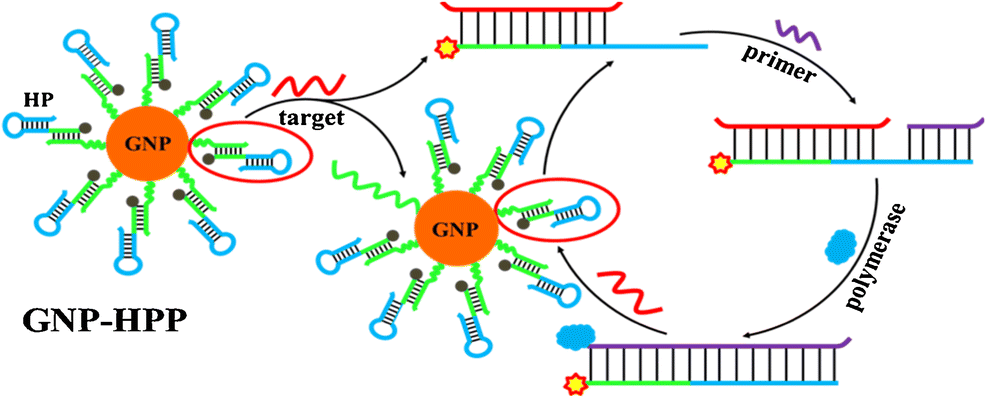当前位置:
X-MOL 学术
›
Microchim. Acta
›
论文详情
Our official English website, www.x-mol.net, welcomes your
feedback! (Note: you will need to create a separate account there.)
Fluorometric determination of the p53 cancer gene using strand displacement amplification on gold nanoparticles
Microchimica Acta ( IF 5.3 ) Pub Date : 2019-07-06 , DOI: 10.1007/s00604-019-3609-0 Weihua Zhao , Hongbo Li , Yongqiong Tang , Mingbin Liu , Suqin Wang , Ruqin Yu
Microchimica Acta ( IF 5.3 ) Pub Date : 2019-07-06 , DOI: 10.1007/s00604-019-3609-0 Weihua Zhao , Hongbo Li , Yongqiong Tang , Mingbin Liu , Suqin Wang , Ruqin Yu

|
AbstractA fluorometric assay is described for the tumor suppressor gene p53. The method is based on strand displacement amplification on gold nanoparticles (GNPs). A FAM-labeled hairpin probe (HPP) is used that can hybridize to the GNP-confined linker strand, and the green fluorescence of the FAM label is quenched by the GNPs. In the presence of the p53 gene, it will hybridize with the HPP. This leads to fluorescence recovery. The primer then hybridizes with the opened HPP and induces the polymerization/displacement reactions. As a result, the hybridized p53 gene is released and, in turn, hybridizes with another HPP on the surface of the GNPs. This triggers the next round of hybridization/enzymatic polymerization/displacement reactions. This results in efficient strand displacement amplification and generates a substantially amplified signal. The method is referred to as GNP-HPP because it involves the use of GNPs and a HPP. The method allows the target DNA (p53) to be quantified down to 1.6 pM concentrations with a linear response in the 5 pM to 1 nM concentration range. In addition, mutant p53 genes can be easily distinguished from the wild-type gene. The method is highly sensitive, selective, and has a low background signal. Graphical abstractSchematic presentation of a chain hybridization signal amplification system (GNP-HPP) based on the use of gold nanoparticles (GNP) as a quenching source for the tumor suppressor gene p53 detection. The hairpin probe (HPP) having a 5′-end modified fluorophore was used as a signalling probe.
中文翻译:

使用金纳米颗粒上的链置换扩增法测定 p53 癌症基因
摘要描述了肿瘤抑制基因 p53 的荧光测定。该方法基于金纳米粒子 (GNP) 上的链置换扩增。使用 FAM 标记的发夹探针 (HPP),可以与 GNP 限制的接头链杂交,并且 FAM 标记的绿色荧光被 GNP 淬灭。在 p53 基因存在的情况下,它将与 HPP 杂交。这导致荧光恢复。然后引物与打开的 HPP 杂交并引发聚合/置换反应。结果,杂交的 p53 基因被释放,进而与 GNP 表面上的另一个 HPP 杂交。这会触发下一轮杂交/酶聚合/置换反应。这导致有效的链置换扩增并产生显着放大的信号。该方法被称为 GNP-HPP,因为它涉及使用 GNP 和 HPP。该方法允许对低至 1.6 pM 浓度的目标 DNA (p53) 进行定量,在 5 pM 至 1 nM 浓度范围内具有线性响应。此外,突变 p53 基因可以很容易地与野生型基因区分开来。该方法灵敏度高,选择性强,背景信号低。图形摘要基于使用金纳米粒子 (GNP) 作为抑制肿瘤抑制基因 p53 检测的淬灭源的链杂交信号放大系统 (GNP-HPP) 的示意图。具有 5'-末端修饰的荧光团的发夹探针 (HPP) 用作信号探针。6 pM 浓度在 5 pM 至 1 nM 浓度范围内具有线性响应。此外,突变 p53 基因可以很容易地与野生型基因区分开来。该方法灵敏度高,选择性强,背景信号低。图形摘要基于使用金纳米粒子 (GNP) 作为抑制肿瘤抑制基因 p53 检测的淬灭源的链杂交信号放大系统 (GNP-HPP) 的示意图。具有 5'-末端修饰的荧光团的发夹探针 (HPP) 用作信号探针。6 pM 浓度在 5 pM 至 1 nM 浓度范围内具有线性响应。此外,突变 p53 基因可以很容易地与野生型基因区分开来。该方法灵敏度高,选择性强,背景信号低。图形摘要基于使用金纳米粒子 (GNP) 作为抑制肿瘤抑制基因 p53 检测的淬灭源的链杂交信号放大系统 (GNP-HPP) 的示意图。具有 5'-末端修饰的荧光团的发夹探针 (HPP) 用作信号探针。图形摘要基于使用金纳米粒子 (GNP) 作为抑制肿瘤抑制基因 p53 检测的淬灭源的链杂交信号放大系统 (GNP-HPP) 的示意图。具有 5'-末端修饰的荧光团的发夹探针 (HPP) 用作信号探针。图形摘要基于使用金纳米粒子 (GNP) 作为抑制肿瘤抑制基因 p53 检测的淬灭源的链杂交信号放大系统 (GNP-HPP) 的示意图。具有 5'-末端修饰的荧光团的发夹探针 (HPP) 用作信号探针。
更新日期:2019-07-06
中文翻译:

使用金纳米颗粒上的链置换扩增法测定 p53 癌症基因
摘要描述了肿瘤抑制基因 p53 的荧光测定。该方法基于金纳米粒子 (GNP) 上的链置换扩增。使用 FAM 标记的发夹探针 (HPP),可以与 GNP 限制的接头链杂交,并且 FAM 标记的绿色荧光被 GNP 淬灭。在 p53 基因存在的情况下,它将与 HPP 杂交。这导致荧光恢复。然后引物与打开的 HPP 杂交并引发聚合/置换反应。结果,杂交的 p53 基因被释放,进而与 GNP 表面上的另一个 HPP 杂交。这会触发下一轮杂交/酶聚合/置换反应。这导致有效的链置换扩增并产生显着放大的信号。该方法被称为 GNP-HPP,因为它涉及使用 GNP 和 HPP。该方法允许对低至 1.6 pM 浓度的目标 DNA (p53) 进行定量,在 5 pM 至 1 nM 浓度范围内具有线性响应。此外,突变 p53 基因可以很容易地与野生型基因区分开来。该方法灵敏度高,选择性强,背景信号低。图形摘要基于使用金纳米粒子 (GNP) 作为抑制肿瘤抑制基因 p53 检测的淬灭源的链杂交信号放大系统 (GNP-HPP) 的示意图。具有 5'-末端修饰的荧光团的发夹探针 (HPP) 用作信号探针。6 pM 浓度在 5 pM 至 1 nM 浓度范围内具有线性响应。此外,突变 p53 基因可以很容易地与野生型基因区分开来。该方法灵敏度高,选择性强,背景信号低。图形摘要基于使用金纳米粒子 (GNP) 作为抑制肿瘤抑制基因 p53 检测的淬灭源的链杂交信号放大系统 (GNP-HPP) 的示意图。具有 5'-末端修饰的荧光团的发夹探针 (HPP) 用作信号探针。6 pM 浓度在 5 pM 至 1 nM 浓度范围内具有线性响应。此外,突变 p53 基因可以很容易地与野生型基因区分开来。该方法灵敏度高,选择性强,背景信号低。图形摘要基于使用金纳米粒子 (GNP) 作为抑制肿瘤抑制基因 p53 检测的淬灭源的链杂交信号放大系统 (GNP-HPP) 的示意图。具有 5'-末端修饰的荧光团的发夹探针 (HPP) 用作信号探针。图形摘要基于使用金纳米粒子 (GNP) 作为抑制肿瘤抑制基因 p53 检测的淬灭源的链杂交信号放大系统 (GNP-HPP) 的示意图。具有 5'-末端修饰的荧光团的发夹探针 (HPP) 用作信号探针。图形摘要基于使用金纳米粒子 (GNP) 作为抑制肿瘤抑制基因 p53 检测的淬灭源的链杂交信号放大系统 (GNP-HPP) 的示意图。具有 5'-末端修饰的荧光团的发夹探针 (HPP) 用作信号探针。


















































 京公网安备 11010802027423号
京公网安备 11010802027423号